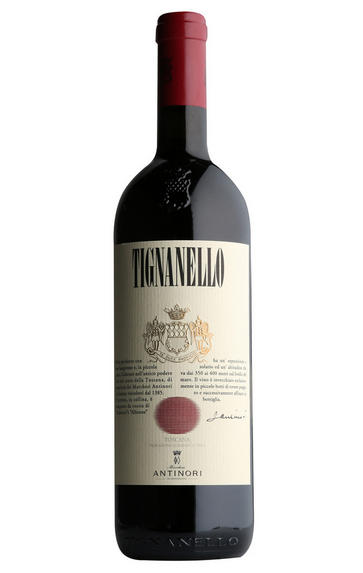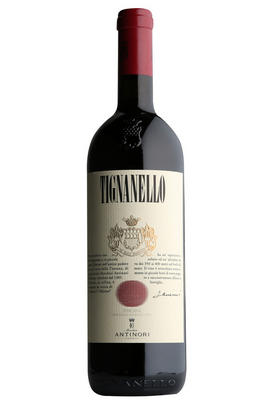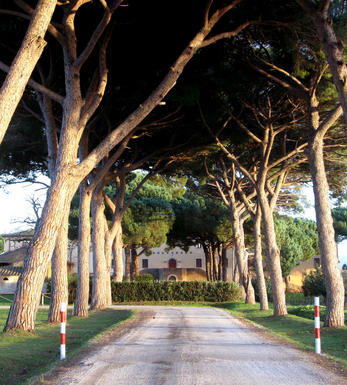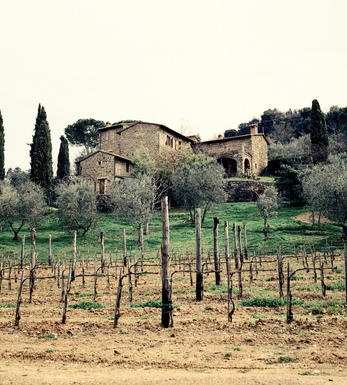
2018 Tignanello, Antinori, Tuscany, Italy

Critics reviews
The 2018 Tignanello is a wine of breathtaking purity. Impossibly silky and persistent, the 2018 is all class, all the way. In many ways, the 2018 reminds me of the 2004 because of its finesse , but it has an extra degree of nuance that reflects important strides that have been made at the estate in the intervening years. Winemaking today is more gentle, while new oak is also less intrusive. The result is a Tignanello that bristles with class.
The purity of the flavours alone is mesmerizing. Bright red-toned berries, mocha, spice, cedar, new leather and licorice are some of the many notes that linger on a finish framed by silky, perfectly ripe tannins. Aging was 16 months in oak, about 50% new. One of the recent developments at Antinori has been a move towards lower toast levels and a preference for longer aging of the raw wood.
The blend is a very typical 80% Sangiovese, 20% Cabernet Sauvignon and 5% Cabernet Franc, with maybe just a touch more Franc than is the norm. At the same time, the Sangiovese is very much front and center. Production hovers around 330,000 bottles. Think about that number. It is more than any Bordeaux First Growth, more than any high-end Napa Valley wine, and equivalent to the production of 60 or so cult Cabernets taken together!
Tignanello, in my view, is the single greatest high quality, estate wine made in scale.
Drink 2028 - 2043
Antonio Galloni, vinous.com (February 2021)
This wine brought to mind precise imagery of tailcoats, striped dress pants, wingtip collar shirts and other gentlemen's fashion choices from the Roaring Twenties. Sporting a retro but classic personality, the Marchesi Antinori 2018 Tignanello is quite the dapper and jovial wine that hits the market just as much of the world is emerging from a dark chapter of lockdowns and coronavirus curfews. I love the optimism that springs bright with such clarity and detail from within this blend of Sangiovese, Cabernet Sauvignon and Cabernet Franc.
The 2016 vintage was a benchmark for sure, but I prefer the 2018, thanks to that tinge of nostalgia or emotion that is so deftly rendered in this cool, long growing season. The 2018 vintage offers a deconstructed Tignanello upon first inspection because you can clearly make out the varietal typicity of the grapes, especially the green spice and white pepper of the two Cabernets, along with aromas of crushed limestone that recall the white rocks carefully placed in the vineyards to protect the rows.
The wine's fruit weight is contained and polished, and there are no exaggerations, excesses or loose ends. The results are calculated and exacting, especially if you consider the tannic management (with aging in both new and used Hungarian and French oak for up to 16 months) and the quality of the elegant mouthfeel. With time in the glass, those deconstructed elements converge to create unity and balance.
The Tignanello vineyard is 57 hectares and sits at a breezy 390 meters above sea level with alberese and galestro soils. Those elevations proved important for shedding excess humidity at the end of this 2018 growing season. Production for this excellent wine is an impressive 345,000 bottles.
Drink 2023 - 2045
Monica Larner, Wine Advocate (May 2021)
This is so aromatic with flowers, such as cherry blossoms and roses, together with currants and blackberries. A medium-bodied Tignanello with very fine tannins and depth. Racy and very, very long finish. Pure and refined. Lots of blue fruit. Tight at the end, but showing a sophisticated and reserved style. Very refined. Drinkable now, but will age nicely.
James Suckling, jamessuckling.com (April 2021)
Fragrant and incredibly refined, this classy red exhibits enticing scents including ripe berry, fine tobacco blend, camphor and dark spice. Smooth and enveloping, the delicious palate boasts a winning combination of creaminess and vibrancy, delivering juicy black cherry, red cherry, licorice and dried mint framed in polished, fine-grained tannins. Fresh acidity keeps it well-balanced.
Drink 2023 – 2033
Kerin O'Keefe, Wine Enthusiast (January 2022)About this WINE

Antinori
Antinori is the most famous name in Italian wine and the influence of Piero Antinori in the last 25 years has been nothing short of revolutionary. Antinori's flagship wine, Tignanello, first appeared in 1971 and caused a sensation by its use of Cabernet Sauvignon in a Sangiovese blend and with its practice of ageing in small French barriques. Antinori was accused of vinous treachery and treason but soon barrique-aged blends of Sangiovese and Cabernet began appearing all across Tuscany.
Solaia is a Cabernet-dominated blend, which, like Tignanello, is from the Santa Cristina estate and is stunningly rich. Tenuta Belvedere is in Bolgheri on the Mediterranean coast .
The Guado al Tasso estate is also part of the small, prestigious Bolgheri DOC zone which has been famous for its Rosé wines since the Seventies: along with the white wines made here, they were awarded the DOC in 1984, which was extended to the reds in 1994. The area is now best-known and admired for its outstanding red wines, the so-called Super-Tuscans. The estate covers over 1,000 hectares, 300 of which are planted with vineyards, and the rest with wheat, sunflowers and olives
Tenuta Guado al Tasso was part of feudal lands of about 4,048 hectares along about 7km of coast and belonged to the Della Gherardesca family, whose roots in this region date back to over 1,200 years ago. In the Thirties the land was inherited by Carlotta della Gherardesca Antinori - mother of Piero Antinori - and her sister, who was married to Mario Incisa della Rocchetta (who took possession of the nearby Tenuta San Guido). There were seven castles on the estate, four of which are still standing, and 86 watchtowers, built 1000 years ago to protect the family from Saracen invaders from the African coast.
There are currently 300 hectares of vineyards at Tenuta Guado al Tasso, situated at an altitude of 45-60m a.s.l. on various types of soil. The varieties planted are Vermentino (a grape variety native to the coastal area of Liguria and northern Tuscany, which has also flourished for many years in Corsica and Sardinia), Sangiovese, Cabernet Sauvignon, Merlot and Syrah. There are also small quantities of other varieties including Cabernet Franc.
Many ideas and resources have been invested in the Guado al Tasso estate, for constant research into improved quality: as a result, a nursery for rooted cuttings was created here in 1994, mainly for the propagation of Vermentino, but also to produce the best possible selections of Sangiovese, Cabernet Sauvignon and Merlot for use in other Antinori estates.
The mitigating influence of the Mediterranean prevents drastic temperature variations and the vines flower and ripen early, thanks to the stable, fairly warm microclimate with its extraordinary light during the final phases of ripening. Thanks to the microclimate of the "Bolgheri amphitheatre", harvesting takes place early here, about two weeks before the Chianti harvest.
The Guado al Tasso estate makes Scalabrone (Bolgheri Rosato DOC) from Sangiovese, Merlot and Syrah, Vermentino di Bolgheri DOC, a monovarietal Vermentino (made for the first time in 1996) and since 1990, the Guado al Tasso Bolgheri DOC Superiore from Cabernet Sauvignon and Merlot grapes.

IGT Tuscany
IGT (Indicazione Geografica Tipica) Tuscany is a wine classification from Italy's Tuscany region. It is one of the official wine classifications recognized by the Italian government. IGT is a step below the highest classification, DOCG (Denominazione di Origine Controllata e Garantita), and above the DOC (Denominazione di Origine Controllata) level.
The IGT classification was introduced in 1992 to allow winemakers more flexibility in grape varieties and employ winemaking techniques while still ensuring a certain level of quality and geographical indication. This classification gives winemakers more freedom to experiment and innovate, deviating from the strict regulations of the DOC and DOCG classifications.
IGT Tuscany wines can be produced throughout the entire region of Tuscany, encompassing various sub-regions and terroirs within the area. This classification allows winemakers to use traditional Tuscan grape varieties, such as Sangiovese, and non-traditional grape varieties, including international ones like Cabernet Sauvignon, Merlot, Syrah, and others.
The IGT Tuscany classification gives winemakers the flexibility to create wines that showcase the unique characteristics of their specific vineyards and winemaking styles. It allows for experimentation with blending different grape varieties, using innovative winemaking techniques, and exploring new regional vineyard sites.
IGT Tuscany wines can vary greatly, from traditional and terroir-driven expressions to more modern and international styles. This classification has played a significant role in developing Super Tuscan wines, often IGT designated and known for their high quality and international recognition.
Overall, IGT Tuscany provides a platform for winemakers in the region to express their creativity and produce wines that reflect their unique vision while maintaining a connection to the rich heritage and traditions of winemaking in Tuscany.

Sangiovese
A black grape widely grown in Central Italy and the main component of Chianti and Vino Nobile di Montepulciano as well as being the sole permitted grape for the famed Brunello di Montalcino.
It is a high yielding, late ripening grape that performs best on well-drained calcareous soils on south-facing hillsides. For years it was blighted by poor clonal selection and massive overcropping - however since the 1980s the quality of Sangiovese-based wines has rocketed upwards and they are now some of the most sought after in the world.
It produces wines with pronounced tannins and acidity, though not always with great depth of colour, and its character can vary from farmyard/leather nuances through to essence of red cherries and plums. In the 1960s the advent of Super Tuscans saw bottlings of 100% Sangiovese wines, as well as the introduction of Sangiovese/Cabernet Sauvignon blends, the most famous being Tignanello.


Buying options
Add to wishlist
Description
The nose is delightfully pure with fruit notes of red and black cherries, spice and menthol. The same purity of fruit continues onto the fine, linear palate; black cherries intermingle with dark berry fruits, hints of spice and minerality. The depth and length on the palate are truly exceptional. Perfectly balanced acidity and very fine tannins make this a harmonious whole wine. This will show well young but will age superbly.
Drink 2023 - 2045
Chris Pollington, Senior Account Manager, Berry Bros. & Rudd (July 2021)
wine at a glance
Delivery and quality guarantee